Football/Soccer Session (Moderate): Creating Angles (Start Time: 14-Nov-2022 19:05h)
Profile Summary

| Name: | Lewis Gibbons |
|---|---|
| City: | Bristol |
| Country: | United Kingdom |
| Membership: | Adult Member |
| Sport: | Football/Soccer |
Description
Topic: Creating Angles
Timing: 50 minute practice, 10 minutes for explanations, interventions and drinks
Ages: Academy: 10+ Grassroots: 12+
Equipment: Balls, Marker Cones, Flats/Disc Cones, Bibs, Goals
Players: Minimum: 8, adaptable thereon
Space: Variable depending on players, minimum 7v7 size
The topic for this practice is Creating Angles. The objective by the end of the session is that players recognise when/how to make angles for teammates on the ball.
The practice focuses on the detail of movement, body shape and timings.
The sessions begins with development of receiving the ball on the back-foot/half turn, after creating an angle for which to demand and then receive the pass.
As the session progresses, players are afforded the opportunity to practice the creation of angles unopposed and in combination with three or four teammates. There are then further progressions utilising supporting runs and more combinations - again, practiced unopposed.
A small sided game is then introduced, reiterating the key coaching detail of movement, body shape and timings, providing the players to practice the topic in a structured competitive environment.
Game related practices represent the two final progressions; the first being a small-sided game which introduces goals and a realistic end-to-end scenario where the coach should further reinforce the structure of the team's shape, movement, body shape and timings to encourage to create angles when central players have the ball. The second game related practice opens up the pitch, divided into thirds, with which the play can restart with a singular central player in any third, akin to the practices through the session, recreating familiar scenarios from which the players have been accumulating knowledge and practice thus far.
This practice is suited to teams who wish to commence a philosophy of playing out from the back and playing through midfield, providing a great foundation to build on creating opportunities in the final third.
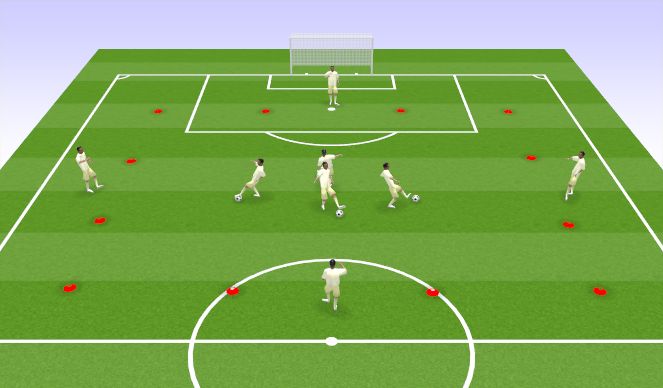
See the guidance at the top of this page to understand why you are not seeing interactive Football/Soccer images.

Learning Objectives

|
Technical Players inside grid: Focus: Setting the body position to receive on the half turn, then demanding the ball, receiving on back-foot (both left and right), good first touch; Quick, close ball control to navigate busy area; Weight of pass into outside player. Players outside grid: Accuracy of pass to players receiving the ball on inside of the grid and weight of pass to player receiving on half-turn; first touch also of importance. |

|
Tactical Players inside grid: Scanning - practice of checking shoulder and surroundings before receiving on the half-turn (the practice assumes the half-turn IS on); Creating an angle between 45 and 90 degrees to receive a pass and recognising this as an effective method to increase probability of being able to receive on the half turn. Players outside grid: Identifying correct foot to pass the ball to of receiver; patience and waiting for the demand of the ball before passing rather than pass to an |

|
Physical Players inside grid: Sprinting into space to create the angle, running at match-pace with the ball, footwork and bodywork to create angle quickly and accurately |

|
Psychological Players inside grid: Decision-making on whom to pass the ball to (i.e. not to pass the ball to players already in due receipt of it |

|
Social Players inside grid: Confidence to demand ball. Players outside grid: Calling for the ball when available/ |
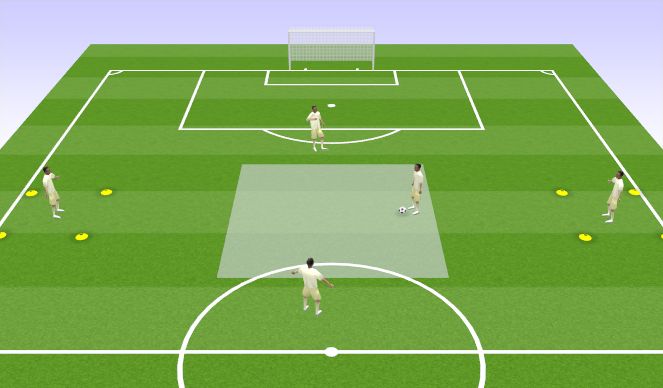
See the guidance at the top of this page to understand why you are not seeing interactive Football/Soccer images.

Learning Objectives

|
Technical Angle of run to zoned player, receiving on half-turn, work of first touch, weight of pass, angle of run between zones |

|
Tactical Creating an angle for zoned player, understanding 2 must create angles either side in this instance; 3rd player creating a second angle after the zoned-player makes first pass (TIMING). Scanning also paramount. |

|
Physical Sprinting into space to create the angle, footwork and bodywork to create angle quickly and accurately |

|
Psychological Decision making on timings - i.e. when to pass the ball (set positions), 3rd man on when to create angle for second pass |

|
Social Communication important between players to create fluidity; taking ownership of intensity in unopposed practice; opportunity to guide others into positions |
Basic Angle Creation (5 mins)
Basic Angle Creation: Recommended Approach
This practice can be mirrored (i.e. clone the set-up across your training area to give multiple groups of players a go). Numbers above based on 5 but can be adapted to more.
The practice constitutes 2 target players at each end "zoned", with three players working between the zones. The central area is shaded for reference; coaches may choose to outline this with flats/disc cones.
The central player plays the ball into the first target player. The starting wide players then create angles, as worked on in the previous practice. The target player chooses a player to pass to, both being ready on the half-turn. Once this pass is played, on the first touch of the receiving player, the central player between the zones creates another angle to receive the ball - the timing here is essential. The point of the sudden sprint to create an angle is to buy time and space, so an early movement from the central player between zones will create a "waiting period" before he receives the ball; which, in a real-game, would enable an opposing marker to catch up with him and render the movement pointless, creating pressure on the ball.
After the central player between zones has made the angle, he receives the pass on the half-turn, playing into the other target player. He then creates an angle on one side, with another player creating an angle on the other, as done in the original pattern. The spare player then becomes the new central player between zones. This requires communication between players. Better still, players could be encouraged to develop their own understanding between each other for who makes the angle and who sits back to become the next central player between zones (e.g. the player who did not receive the pass from the previous target player becomes the next central player between zones to guarantee an opportunity on the ball).
The detail in this practice is fundamental to the philosophy of a team who wishes to play from the back and/or progress through midfield areas centrally. It is important that body shape, movement and timings are stressed as coaching points. Once mastered, it can become tiresome (too easy) and requires progression.
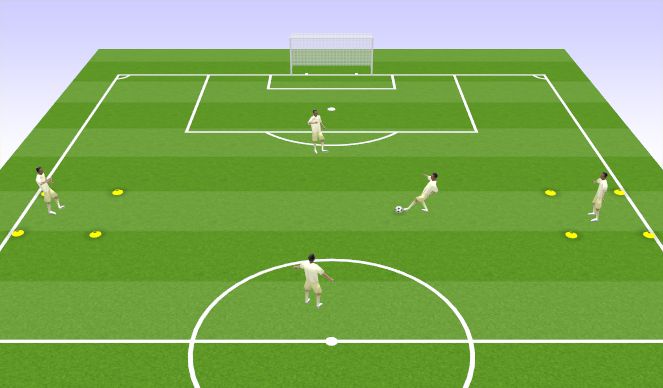
See the guidance at the top of this page to understand why you are not seeing interactive Football/Soccer images.

Learning Objectives

|
Technical Angle of run to zoned player, receiving on half-turn, work of first touch, weight of pass, angle of run between zones and around players before 3rd pass |

|
Tactical Creating an angle for zoned player, understanding 2 must create angles either side in this instance; 3rd player creating a second angle after the zoned-player makes first pass (TIMING). The 3rd pass needs to be played in front of the running player; there also needs to be understanding on who then falls back into the 3rd-man position and who creates the 2 angles for the zoned-player. Scanning also paramount. |

|
Physical Sprinting into space to create the angle, footwork and bodywork to create angle quickly and accurately, changing direction |

|
Psychological Decision making on timings - i.e. when to pass the ball (set positions), 3rd man on when to create angle for second pass |

|
Social Communication important between players to create fluidity; taking ownership of intensity in unopposed practice; opportunity to guide others into positions |
Creating Angles and Combinations (5 mins)
Creating Angles and Combinations: Recommended Approach
An optional progression on the previous practice, this employs the same fundamental of angle creation with a variation on the immediate movement between passes. In this example, players creating an angle rotate their forward runs and receive the ball again from the central player between zones before passing into the target player. The player passing into the target player then drops off into the central area between zones, whilst his predecessor creates one of the two angles.
There are various other movements and combinations which can be tried and tested here at leisure. The importance again is to ensure the movement, body-shape and timing of players when creating angles as the core coaching point, challenging players to maintain quality and diligence whilst also thinking about how they can combine between creating angles.
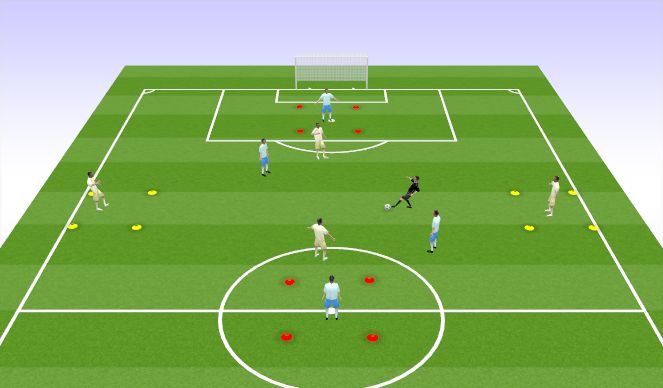
See the guidance at the top of this page to understand why you are not seeing interactive Football/Soccer images.

Learning Objectives

|
Technical Angle of run to zoned player, receiving on half-turn, work of first touch, weight of pass, angle of run between zones |

|
Tactical Creating an angle for zoned player, understanding 2 must create angles either side in this instance; 3rd player creating a second angle after the zoned-player makes first pass (TIMING). The 3rd pass needs to be played in front of the running player; there also needs to be understanding on who then falls back into the 3rd-man position and who creates the 2 angles for the zoned-player. Understanding when these opportunities arise which combinations are possible and achieve the clearest route to end-zone. Scanning also paramount. |

|
Physical Sprinting into space to create the angle, footwork and bodywork to create angle quickly and accurately, changing direction. Opposed must be strong protecting the ball and/or getting to the ball first; change of direction or feinting essential for moving off of marker; endurance in defensive transition |

|
Psychological Decision making on timings - i.e. when to pass the ball (set positions), 3rd man on when to create angle for second pass; recognising opportunities and remembering under pressure (now in opposed practice); composure on the ball under pressure |

|
Social Communication important between players to create fluidity; taking ownership of intensity in unopposed practice; opportunity to guide others into positions; competitive engagement and opportunity to score points and/or |
SSG: 4+4 vs 1 - Angles Game (10 mins)
SSG: 4+4 vs 1 - Angles Game - Recommended Approach
This game follows the unopposed practices with the exact same principles; except, this time, there are 2 target players placed in the other direction. This game can be practiced as demonstrated with a neutral player with odd numbers, where target players are immune to tackles to encourage the 3v2 overload in play. This can also be played with even numbers, where target players are unprotected (i.e. they can be tackled), drawing in pressure to create overloads elsewhere on the pitch. For this game, target players are restricted to their zones.
Teams are encouraged to create angles, play through the field and reach their target player. Scoring systems can be varied depending on success, though I score a point for teams every time they play into a target player, receive the ball, play through the field and successfully pass to their other target player.
The game has an element of transition, when the opponent wins the ball and the shape of the pitch changes due to the multi-directional set-up. This adds an unpredictable element of defensive positioning which the team in-possession need to overcome, as well as the spread/distribution of their teammates on immediate recovery of the ball.
The team in-possession can receive the ball from a target player and play back to him if the forward pass is unavailable. This protection blanket can hinder forward play and so a rule could be introduced that, in this scenario, the target player cannot then play again to the same player. A coaching point here is that if a player "creates an angle" and shows for the ball but does not receive it within seconds, they should look to rotate and take up the position of the central player between zones or the adjacent angle to the target player in possession. This creates space for which to receive a pass, also providing the player in possession with evolving options.
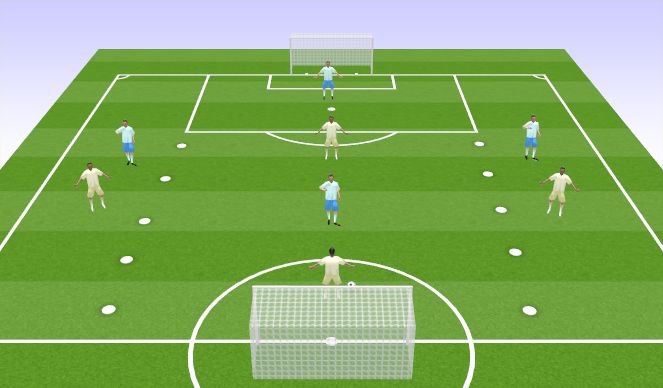
See the guidance at the top of this page to understand why you are not seeing interactive Football/Soccer images.

GRP: Small Sided Conditioned Game (10 mins)
Game Related Practice: Small Sided Game
This small-sided game introduces the realism of direction and goals as expected from match-day. The game should be conditioned to encourage the creation of angles, either by having game-restarts commence with a deep central player or a central player between the goals (similar concept of central player between zones in previous practices) play backwards into a central player.
The idea here is that the opponents are drawn into the team in-possession's half, creating space in the opponent's half to exploit. Once the deepest player receives the ball and is under pressure, angles can be created in the various patterns worked on already to play through the field.
The pitch is marked up vertically to serve as a guide to the width required for the creation of angles.
Otherwise, the rules are the same as a normal game but with the impetus on creating angles.
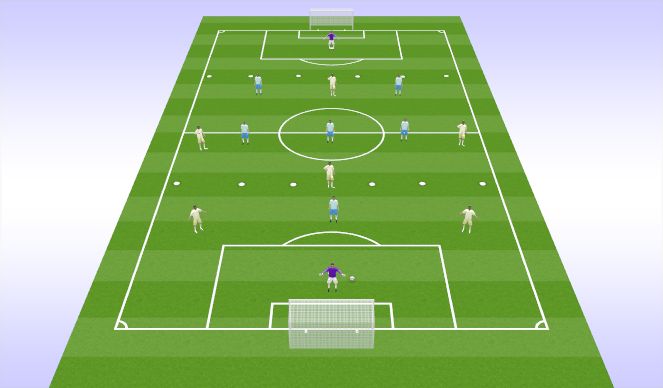
See the guidance at the top of this page to understand why you are not seeing interactive Football/Soccer images.

GRP: Conditioned Game (10 mins)
Game Related Practice: Conditioned Game
A real game on the full-length of the pitch which, again, is conditioned on possession-restarts. This time, the pitch is marked into thirds, so on possession restarts, the coach can choose a third from which the ball is played centrally. The team in-possession then must work-out how to create angles and play through the field.
This practice also encourages outfielders to give the ball to the goalkeeper and create angles for him to receive it again. Once they have received it again, then the next angles should be made to progress up the pitch - timing is so important is a key coaching tip at this stage.







 Play animation
Play animation Play step-by-step
Play step-by-step Repeat (toggle)
Repeat (toggle) Full Screen
Full Screen Pause
Pause Stop
Stop
Receiving on Back Foot (10 mins)
Receiving on the back foot: Recommended Approach:
Create a square/grid with marker cones. Size variant on number of players. Ask players to pair up, labelling themselves "1 and 2". Those numbered 1 start on the outside of the square/grid in a space. Those numbered 2 start on the inside, with a ball, opposite their partner. Unpartnered players can take a turn on the inside and outside.
Players on the inside then pass firmly to their partner, creating an angle between 45-90 degrees (sprinting). They then turn, side-on, such that they can view the entirety of the square/grid. Once checking their shoulder (scanning) for traffic (it will be free as unopposed practice, though forms good habits), they demand the ball to their back foot. It should be stressed to outside players that the pass is not played until the player is "set" and demands the ball. The ball again should be played with good weight.
The inside player's first touch on their back foot should set them travelling into the square/grid at match-pace. They should quickly identify a new player to pass to, and perform the same routine as above. Outside players should be encouraged to communicate their availability. Inside players should be encouraged to watch for players already being passed to, perhaps calling the name of the outside player to attract their attention and initiate the pass.
Coaching tips:
Scanning - when players are checking their shoulder during an unopposed practice, have them identify a colour or shape of a brand-logo or club-logo of another player on the outside of the grid, to encourage practice of absorbing information during the scan.
Outside passing - outside players should be able to accurately identify the back-foot and play the pass as desired.
Inside receiving - players on the inside should be encouraged to practice receiving on the "back foot" of both their left and right sides.
Intensity - work the players for 60 seconds, encouraging realistic match-speed, after which they swap-over with their partners from in-to-out as being on the outside can be deemed more of a rest.